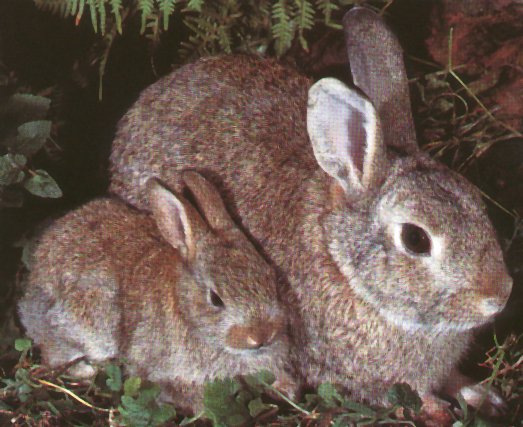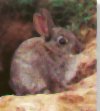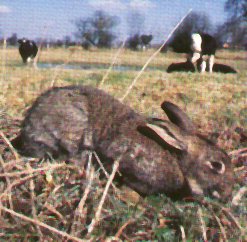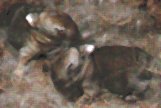
European Rabbit

Order: Lagomorpha Family: Leporidae Genus & Species: Oryctolagus cuniculus
A native of France, Spain, Portugal and northwestern Africa, it has been introduced to much of Europe, Australia, New Zealand, Chile and Argentina. A single female can produce more than 30 young in each breeding season.
| Habitat With a range that now includes countries in both the southern and northern hemispheres, the European rabbit has adapted to a variety of habitats, from stony deserts to sub-alpine valleys. It is found on grassy coastal clifftops, in fields and in larger parks. The rabbit is normally seen grazing on short turf within easy bolting distance of its burrow, where it hides from predators and shelters from the heat or cold. |
 |
| Though seldom found at altitudes above 600m, it prefers hilly terrain in
which to build its burrow system, as digging horizontally into sloping ground is much
easier than having to dig downwards. Despite its origins in generally warm climates,
the rabbit can tolerate a wide range of temperatures, and is able to live comfortably even
in the colder parts of northern Europe, where it was introduced by the Romans as a source
of food some 2000 years ago. |
 |
Behaviour The rabbit's behaviour is governed by the fact that it is the staple diet of many predators, including foxes, wildcats and owls. Consequently, it is very cautious and essentially nocturnal, spending the day in its burrow and emerging at dusk to feed within 200m of its refuge. |
| In habitats where the soil is soft and easy to burrow into, individuals
tend to space themselves out. Home ranges may overlap, but each rabbit occupies its
own burrow. In areas with hard, chalky soil, a number of rabbits live together in
one complex burrow system, or warren. The warren may be 3m deep and 45m long, with
many tunnels, chambers and exit holes. |
Feeding A strict herbivore, the European rabbit feeds mainly on grasses and herbage. In winter it eats other items, including twigs and the bark of trees. It also attacks agricultural crops with gusto and as a result many farmers go to great lengths to eradicate them from their land. The rabbit's primary feeding tools are its long, broad incisor teeth, which are adapted to nibbling and shearing low-growing grasses as well as gnawing and browsing other tough vegetation. |
 |
| Like a rodent, its front teeth grow continuously and never wear out.
The cheek teeth, or molars, then grind the food to a pulp. The rabbit also
supplements its diet by scratching in the soil with its front claws for roots and bulbs.
In common with all rabbits and hares in the order lagomorpha, it eats its own
first-passed, soft droppings to obtain extra nutrients. |
 |
Breeding In its native range the European rabbit breeds from late winter to summer, but in the warm Australian climate, for example, it can breed year round. Breeding is also affected by the food supply, as the demands of reproducing would waste vital energy if shortages occur. At such times, a female may reabsorb any embryos that she is carrying back into her body. |
| During the mating season the male becomes territorial and marks out his own patch with a scent gland under his chin. He then defends this area against intruding males and tries to mate with all the females whose own home ranges lie within his territory. About four weeks after mating, a female gives birth in an underground chamber to a litter averaging 5 or 6 young. She leaves her young in the chamber while she feeds at night, but returns once to suckle them for a few minutes. The young rabbits grow rapidly and are independent by about five weeks. |